
Hi there! Welcome to Easy A–Your go-to source for quick and easy actions you can take in five minutes or less about the issues you care about.
Are you a busy mom? Or maybe your work is so hectic you can’t think about anything else during the day? A lot of us are also taking care of parents or other loved ones too, leaving little time for anything else.
The good news is that these are things you can do while you’re waiting in the school pick up line, on your lunch break, or even at your kid’s soccer practice – anywhere you happen to be! And you can easily share Easy A with your friends so they can be in the know, too! We’ll send you a new action to take every week–just one, we promise –and it will always be something you can do in five minutes or less. Ready to get started? Let’s go!
Watch This: How RWB Women Found Joy in 2025
As we reflect on 2025, we’re in awe of how much the women of Red Wine & Blue accomplished. It’s beautiful to see that even while facing the rise in extremism, we’re still able to find joy in our work together.
See for yourself! Take a minute to watch this video recap of our year. It’s hard not to feel the love and good vibes that come hand-in-hand with making positive change in our communities.
In 2025, Red Wine & Blue and our TroubleNation groups held a staggering 4,212 events that were attended by 83,443 people. This video gives just a hint of what it was like to be there.
Craftivism gatherings. Banned Book Club meetings. Advocacy Days at state legislatures. Troublemaker Trainings on how to protect democracy. No Kings rallies. Our Inaugural TroubleNation summit. Rally Together outreach to get friends and family ready to vote. And so much more.
Being together in these ways and seeing the impact of our work (remember all these wins?) helped us stay energized and hopeful in 2025. We can’t wait to do even more of this in 2026!
Read This: Dear 2026
The end of 2025 is in sight, and for a lot of us, that is cause for celebration!
The year started with the inauguration of the Trump administration, and from day one, they took actions that harmed average Americans. From dismantling the Department of Education, to enacting tariffs that raised the prices of our everyday goods, to shutting down diversity and inclusion efforts everywhere, to snatching our neighbors right out of their homes and workplaces – they made much of 2025 a total dumpster fire.
So maybe you’re celebrating the END of this painful year, but believe it or not, there are also some good things that happened. We want to celebrate those, too.
It would’ve been easy to give up in January and just try to get by, but we refused. Instead, we started the year with our historian friends Heather Cox Richardson and Timothy Snyder who inspired us to not give in to extremism, and to go local to protect democracy instead. In doing so, we accomplished some pretty amazing things:
- Our membership grew by over 190,000 people!
- TroubleNation exploded to more than 800 local groups!
- We launched our new RWB App and more than 29,000 of you are already using it!
- We celebrated incredible election wins in November that set the stage for an even better 2026.
So if we take away one main lesson from 2025, it’s that if we stick together, hold onto hope and joy, and keep going, we can do great things!
Now we’re kicking off our most fun and forward-looking year-end celebration ever, and for the next few weeks, we want you to join us!
We’re not just saying “good riddance” to a year filled with mostly crappy things, we’re celebrating how we turned it around and have lots to look forward to in 2026.
A new year offers us endless possibilities. We’re taking this time to reflect and plan, and that’s where our Dear 2026 campaign comes in. We’re writing letters to our future selves, celebrating the work of intrepid women with our first ever Troubbies awards, and donating to support more women’s democracy-saving work next year.
But to kick things off, we’re starting with a little fun. We designed this special deck of tarot cards to give you some insight into what your 2026 with Red Wine & Blue holds. Give the deck a shuffle, pull the card you’re most drawn to, and see what special message you receive for 2026.
Then, if you have a little extra time, click here to head on over to our Dear 2026 campaign page to learn about the rest of our year-end celebrations and our intentions for an amazing year ahead. And feel free to share with friends!

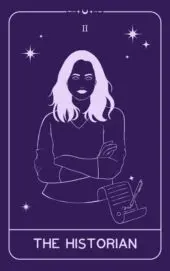




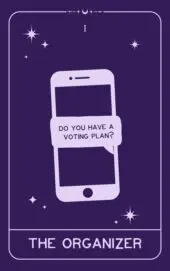

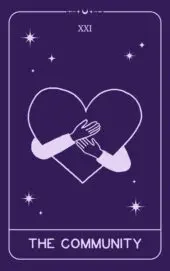


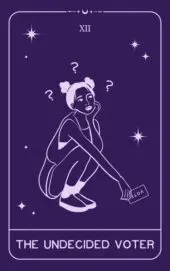
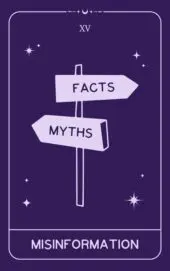

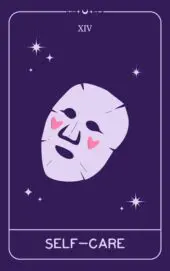






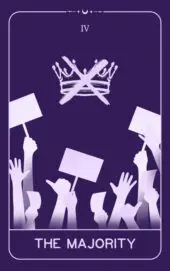
*Note, this is all for fun and entertainment! We aren’t tarot experts and we can’t predict the future, but we know one thing’s for sure – we’ll keep fighting extremism in 2026 and we want you with us!
Do This: Join Us for Wins in 2026
We’re still riding the high of all the local election wins we celebrated earlier this month – not just because it feels good to win, but because it means common sense and human decency are leading the way again in so many of our communities.
Let’s take one more victory lap before the holidays! In the races that we backed this election cycle, we won:
- 72% of the school board seats
- 78% of the Michigan school bonds and millages
- 81% of the Virginia House of Delegate seats
- 100% of Pennsylvania’s statewide judicial seats
With these wins, we protected students, public education, reproductive rights, voting rights, and democracy itself. And make no mistake, going local made this happen. Our members made this happen.
Do you want to be a part of all this winning in 2026?
No other organization has a community quite like ours. Our members are deeply connected where they live, which means we have local information that no other organizations have, and we can connect with voters like no other organization can. Just consider that our members contacted 106,000 of their friends and family and turned them into voters this year to get these wins!
What we’re learning from these 2025 local elections is already helping us prepare for the 2026 midterm elections. The work starts now, and it’s easy when you do it with friends and neighbors! So easy, it’s your Easy A this week!
Watch This: Celebrating 2025 School Board Election Wins
Last week’s elections gave us a lot to celebrate.
We’ve already highlighted some exciting statewide and municipal wins. Now let’s take three minutes to watch a round-up of inspiring school board victories:
This is exactly what we mean when we say “going local” matters. Candidates winning by 7 votes! Write-in candidates winning! Even in counties in Virginia and Pennsylvania that were the heart of the culture wars started by Moms for Liberty – boards were flipped and extremists were sent packing.
Voters proved that anything is possible when we pay attention locally and show up. We overwhelmingly voted for common sense, not division. In doing so, we protected our kids and their education. Next week we’ll show you an easy way to build on this momentum in your community.
Read This: Celebrating 2025 Local Election Wins
Voters made a big statement this week: Common sense and human decency are still our values, and we’ll keep showing up to fight extremism head-on.
You’ve probably heard about some exciting election wins, including Virginia electing its first female governor, Abigail Spanberger, and New Jersey electing its first Democratic female governor, Mikie Sherrill. Virginia also chose Ghazala Hashmi as their lieutenant governor, making her the first Muslim woman to be elected to a statewide office anywhere in the U.S.
There were also big wins that will help protect democracy against extremism, like Pennsylvania retaining three state supreme court judges, California passing Prop 50 to fight congressional gerrymandering, and Maine blocking an attempt to restrict their absentee voting.
But let’s also look at some local wins you might not be hearing about, and how voters made a powerful impact in our communities:
- Mary Sheffield was elected as the first woman mayor of Detroit, Michigan.
- Our Suburban Women Problem podcast host Amanda Weinstein won her city council race in Hudson, Ohio.
- 15 Red Wine & Blue members won various local races in North Carolina.
- In the town of Midland, NC, Isaac Davis was elected to the town council by a huge margin – becoming the first Black person to be elected to any position in the town.
- In Bucks County, Pennsylvania, which was ground zero for extremist takeovers of school boards back in 2023, the Central Bucks and Pennridge boards were flipped back to commonsense candidates.
- Despite extremists pushing their anti-trans agenda in Virginia, two candidates who will protect trans students – Ross Svenson and Monique Bryant – were elected to school boards in Loudoun and Arlington Counties.
- Ohio also saw commonsense school board candidates beat extremists in Trump-supporting places like Geauga County and Mentor, North Royalton, and Brecksville–Broadview Heights.
- Almost 78% of the school bonds and millages we supported in Michigan passed.
And these are just a handful of the stories we’re hearing!
These wins mean that in these communities, more people will see themselves reflected in their local leadership. Public schools will get the funding they need. Books will stay on classroom and library shelves. Teachers will be free to teach honest and accurate lessons. LGBTQ+ students will feel welcome and supported.
We know about these inspiring, local stories because of our amazing members working on the ground with us year-round in your own communities. You helped make them happen and we thank you for being with us. Take this moment to celebrate these victories and stay tuned – next week we’ll celebrate some more local wins as the stories keep rolling in!
P.S. If you have a little extra time tonight, join us for our virtual RWB Family Meeting to unpack election results and talk about what comes next. You’ll be the first to hear more stories like these from some of the most consequential local races in the country. Grab your bevvie of choice, get comfy, and log in to spend time with the RWB family! If you can’t make it, register anyway and you’ll be emailed the recording to watch when you have time.
Do This: Share November 4 Elections Information
On November 4, Americans have 53,000 chances to tell extremists that we don’t want them in power. That’s how many open seats are on ballots nationwide in our upcoming local elections.
But municipal elections generally have low voter turnout, especially in years like 2025 that don’t have presidential or congressional races. Usually less than 20% of registered voters show up, but too much is at stake right now to let that happen this year.
We know that the majority of Americans share our values and want commonsense leadership. We see it in poll after poll, at the No Kings protests, and in every event Red Wine & Blue hosts! So we need to make sure that we’re the majority using our voices at the ballot box. That starts by making sure that people know these elections are even taking place. We’ve made that easy for you to do this week!
Share this ready-made message using your favorite social media and messaging platforms to let people know about their Nov. 4 local elections:
Do This: Help Your Friends Make Their 2025 Voting Plan
Did you know that Americans get their local news from friends, family, and neighbors more than any other source of information? That means it’s on us to make sure that the people we know are informed about upcoming local elections and have a plan in place to vote.
You made your own voting plan last week; now let’s take it one step further and help everyone you know make their voting plans, too!
If you’re already using the Red Wine & Blue app, you can use the Rally Together tile to generate a personalized voting plan for your friends with just a few clicks. Watch this video tutorial to see Julie create a personalized voting plan in under three minutes!
If you’re not on the app yet, no worries, you can find step-by-step instructions for downloading the app and getting started with Rally Together here at redwine.blue/go/. It only takes a few minutes, and you can be sending your people their personalized voting plans in no time.
You can also share this direct link to our “My 2025 Voting Plan” worksheet for people to fill out for themselves.
The 2025 municipal elections are our opportunity to elect commonsense local leaders and regain power nationwide. Let’s make sure everyone we know is prepared and shows up to vote!
Do This: Make Your 2025 Voting Plan
Election Day – November 4 – is right around the corner, and it’s never too early to make your 2025 voting plan!
Use vote.org or your state’s board of elections website to complete this step-by-step checklist:
- Check your voter registration status. Make sure that your voter registration is active. If it isn’t, check out your options. Many states let you register at the ballot box.
- Check your state’s voter ID requirements. Make sure you have what you need.
- Decide how you’re voting. Are you voting early in-person? By absentee or mail-in ballot? Or in-person on election day? Your options will vary depending on where you live.
- Look up your early voting schedule and location(s).
- Look up your election day polling location(s) and hours.
- Research what’s on your ballot. Be prepared to vote for every race and issue on your ballot. Learn about your candidates and also make sure you know about any local bonds, levies, millages or other ballot initiatives. If you live in the following states, you can use our additional resources to educate yourself:
- Decide when and where you’ll vote, and put it in writing! Print and use this form to take with you to the ballot box. Don’t forget to plan for transportation, childcare, and anything else you may need to carry out your plan.
You know why it’s important to vote in local elections this November. But did you know research shows that people who make a plan to vote are more likely to actually do it? So let’s get our plans in place and make a difference this year through our local elections. As Heather Cox Richardson told us, it’s our best chance to save democracy!
Watch This: Why We’re Going Local in 2025
It’s easy to get overwhelmed by the chaotic, 24-hour national news cycle and our emotionally charged social media feeds. Everything can feel so big; so distant; so daunting. So isn’t it comforting to know that the best way out of the chaos is to keep our focus close to home?
Last week we gave you five reasons why we “go local.” This week, take one minute to listen to our favorite historian, Heather Cox Richardson, as she explains why focusing on the 52,000+ local races on our ballots this November is the best way to change the direction of our country right now.
Heather shared this wisdom and historical context with us during our recent event, Our Best Chance to Save Democracy. We don’t have to wait until 2028, or even 2026. We can make a difference this year in local elections. Starting in our own communities, we can begin to regain control over the chaos. Next week, we’ll take another easy action together to get started.
Read This: Five Reasons Why We “Go Local”
Lately, you may have seen Red Wine & Blue say, “When they go low, we go local!” What do we mean by that?
Almost a decade ago, Michelle Obama made famous the phrase, “When they go low, we go high.” This was the Obama family motto for responding to cruel, hateful bullies. Inspired by that, we’ve created our own motto for how we’re responding to the current threats coming from the federal government – when they go low, we go local.
In the face of these threats to public education, vulnerable communities, diversity and inclusion, the environment, our freedom of speech, and so much more, we know that the most effective way to respond and to protect the things we care about is to get involved locally.
Here are five reasons why going local is the best way to fight back.
- It’s the most effective way to protect your most vulnerable friends, family, and neighbors against federal threats. The most immediate protections for vulnerable communities come from local government. Let’s say you want to protect your immigrant neighbors. Sure, you can call your U.S. Congressperson, but it’s even more effective to work with your local schools and city government to make sure they have policies in place to protect families against unlawful ICE raids in schools and courthouses. Similarly, if you want to protect transgender kids in your community, you can work to make sure your local schools have policies in place that respect and protect them, and that local medical facilities continue to provide them with the healthcare they need.
- All your power is local. Research shows that public opinion doesn’t sway U.S. Congress nearly as much as it sways local school boards, city councils, municipal offices, and state legislatures. Take, for example, a small group of 10-15 people with strong voices. They may not influence a U.S. representative, but they can make a big impression and influence their town councilperson.
- It’s an opportunity rich environment. There are more than 58,000 local seats up for election between now and the end of the year. Even if you don’t normally care for politics, if you care about schools, libraries, roads, and local development, you should care about these races! Plus, this is our chance to stop extremists from getting local power and political experience that they would use to keep getting elected to higher and higher offices with even more power.
- It builds year-round local infrastructure. Extremists have been successfully organizing and building ground locally for over four decades. They’ve used churches, social clubs, and grassroots organizations to build benches of local politicians and gain the power that they have today. We need to do the same, by organizing our communities and building our own bench of commonsense politicians who work for all of us.
- It reduces polarization. Focusing on local issues has been proven to reduce polarization in communities. It’s easy to find common ground when you’re literally talking about the ground and shared spaces that you have in common.
Now let’s put the spotlight back on reason #3 for a second. Some states have primary elections this month, and most states have general elections in November. Voter turnout is usually pretty low in local elections, especially in years like this that follow a big presidential election. A lot of us took last year’s loss pretty hard, but now is not the time to step back.
Since turnout in local elections is so low, very small numbers can swing the outcomes, so every single vote counts. And after the year that we’ve had so far, wouldn’t it feel good to get some wins this November? Over the next few weeks, we’re going to talk about the many ways you can go local to help make that happen!
Do This: Unite Against Soft Censorship
The only way to end censorship, whether it’s the quiet removal of books from library collections or in-your-face book bans, is to fight it head on.
We saw a huge example of this – and a big win for free speech – this week when ABC and Disney returned Jimmy Kimmel and his late-night show to the airwaves after they received massive public pushback to his recent suspension.
It’s hard to believe we have to say this out loud, but no political censorship of any kind should ever happen in America. We can’t let anyone in power try to normalize it. That’s why advocating for our freedom to read is one of Red Wine & Blue’s top priorities. And that’s why we have ongoing programming through our Book Ban Busters campaign, including our partnership with Unite Against Book Bans.
Unite Against Book Bans is hosting Banned Books Week from October 5-11, including Let Freedom Read Day on October 11. Our next Banned Book Club meeting is just after that on October 15.
You can stay informed about news and other events like these by signing up for updates from our Book Ban Busters campaign. Click here to be taken straight to the signup form on our Book Ban Busters webpage. You’ll be the first to know about any news or special events we have about book bans and censorship, but no spam!
Let’s work together to make sure that we can all keep reading whatever we want, whenever we want, for generations to come.



